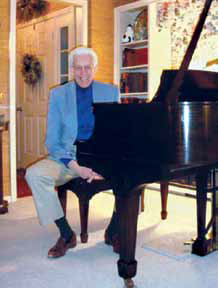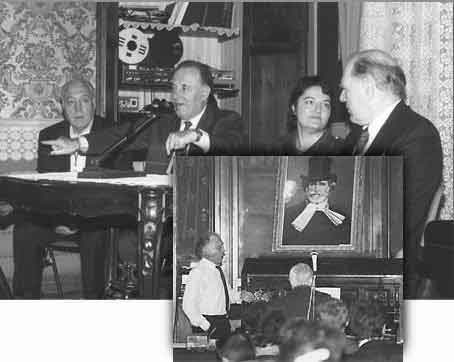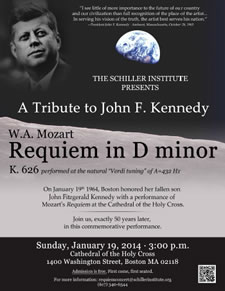Message to the Schiller Institute 2014
Concert and Tribute to John F. Kennedy
by Anthony Morss, Conductor
January 2014
The following statement was sent to the Schiller Institute Tribute to JFK by Anthony Morss, the Music Director and Principal Conductor of the New Jersey Association of Verismo Opera, Inc.
On Sunday, January 19, 1964 a performance was given of Mozart's Requiem Mass in Boston honoring the recently assassinated John F. Kennedy. The Mozart had been specifically requested by his widow, Jacqueline Kennedy. And on January 19, 2014 the Schiller Institute will present another performance of the Mozart Requiem in memory of president Kennedy--50 years later, to the day---at the Cathedral of the Holy Cross in Boston. This event will honor Kennedy's legacy of inspiration, especially in young people, of the patriotism and soaring idealism which produced the Apollo moon project and the Peace Corps and the entire climate of hope and confidence associated with Kennedy's Presidency.
One of the most significant features of the January 19 performance will be its tuning pitch of A=432, thereby forging a powerful link to a tradition of deep authenticity beyond the awareness of the average concertgoer. It will be useful to examine some of the history of tuning in order to realize its significance for us today in participating fully in our magnificent cultural heritage.
The Dilemma of Tuning Pitch

Anthony Morss. |
It is not at all surprising that when the high art music of the Renaissance and Baroque was emerging, Europe was so politically divided and communication so slow that there was no consistent tuning pitch. This situation continued well into the nineteenth century. Different cities tuned to different pitches, and different churches within the same city tuned to different pitches. Since the most important music was overwhelmingly vocal, sometimes the only real clues to knowing where to tune came from the range of the vocal parts: voices do have limitations, especially those of church singers not always professionally skilled.
The various tuning pitches were almost always lower than modern tuning, an extreme example being the prestigious Paris Opera at the time several of Gluck's operas were premiered there: it is known that the tuning at the Paris Opera then was a minor third lower than modern A=440. Music written in F major would thus sound to modern ears in D major. The only solution for a modern performance would be to transpose the whole opera down a minor third. Otherwise some of the solo tenor parts, which are written very high, would be excruciating. By the way, during this period Rome used the same tuning as the Paris Opera; Naples was a half-tone even lower, and Venice tuned to our modern 440. Most emphatically, one size obviously does not fit all. (1)
Today we face the choice of where to tune in order to do justice to the standard repertory. Bach and Handel both worked in some cities where the pitch was a whole tone down from 440, and later on in places where it was only half a tone down. Modern orchestras that play Baroque music have agreed internationally to use modern copies of Baroque instruments tuned to 415, which is a half a tone down from 440. Those orchestras that play Haydn, Mozart, Beethoven, Schubert and Mendelssohn by common consent tune at 430, which is nearly a quarter of a tone down from 440. (A full quarter-tone would be 427.)
Laboratory tests conducted in the nineteenth century and repeated in the twentieth, (including by the legendary Amadeus Quartet's first violinist, Norbert Brainin, also in collaboration with the Schiller Institute), confirmed that the great stringed instruments of the old Italian masters such as Stradivarius, Guarneri and Guadagnini achieve their maximum resonance (which is to say their maximum roundness and beauty of tone) between 427 and 432. Actually 432 is ideal because it derives from middle C at 256, a major scientific constant: for example, the characteristic vibratory rates of the subatomic particles are all within this same scale of values.
II

From left to right: Piero Cappuccilli, Carlo Bergonzi, Liliana Gorini and Lyndon LaRouche in,November 1997, at the Salone Barezzi di Busseto, at the conference presenting book "Canto e Diapason", the Italian edition of the Schiller Institute’s “Manual on Tuning and Registration.” Piero Cappuccilli demonstrated “Oh dei verd’anni miei” at the Verdi pitch (La=432 Hz) during the first conference on the scientific tuning at the Casa Verdi in Milan in November 1988. |
The most compelling reason to tune at 432, championed by the great Giuseppe Verdi himself, is not just its scientific and theoretical significance but rather the extremely obvious gain in beautiful tone for stringed instruments, as we have seen, and even more important, for the singing voice. Nor is this improvement noticeable only to connoisseurs: the average concertgoer is immediately aware of the added glow of warmth and mellowness, especially if there is an opportunity to compare directly with the modern higher tuning.
Such an opportunity was provided in April 1993 by the Schiller Institute during a seminar conducted by the renowned Carlo Bergonzi at New York City's Carnegie Hall, in its Weill Recital Hall, entitled "Save The Art of Bel Canto--Return to the Verdi Tuning". A parade of singers of all voice categories sang each an aria with a piano tuned to 440 and then repeated it with a different piano tuned to 432. Both singers and the public found this comparison startlingly favorable to the 432 tuning.
One can build wind and brass instruments to tune up at any pitch one chooses, but the human voice cannot be so tuned. The great Italian Maestro Tullio Serafin deplored the modern high tuning (at 448 and up) and prophesied that if it continued, it would result in "the death of the Italian Lyric Theatre." This high tuning is currently burning out voices, shortening careers and forcing opera companies to cast lighter, lyric voices with easy high notes in roles demanding darker and heavier voices, ones that can no longer reach the too-high top notes. No matter how supportive the conductors may try to be in keeping down the orchestral accompaniaments for lighter voiced singers, the heavy orchestrations meant to support heavier voices will eventually destroy the lighter voices, which are in any event all the wrong color for the heavy roles, and thus seriously misrepresent the music they are singing.
Whichever tuning most favors the human voice must be the standard one for all music, with due exceptions made for transpositions of music composed to be performed at startlingly lower tunings. But the vast majority of works in the standard repertory will be found to be best served by the 432 tuning.
Anthony Morss
Music Director and Principal Conductor
New Jersey Association of Verismo Opera, Inc.
January 7, 2014
Footnote:
(1.) If we assume that all the best composers everywhere in Europe knew how to write for voice effectively, then perhaps much of their vocal writing achieved very comparable results in pitch, by having composers in the low tuning cities write high, and composers in the high tuning cities write low. When Bach guest-conducted outside of Leipzig, he always took with him different wind transpositions to set the actual pitch of his pieces very close to the Leipzig conditions for which he had composed them.
What was Bach's own preference in tuning pitch? As it happens, we know that because Bach was a famous organ consultant, as well as a famous composer and organ virtuoso, and drew up the specifications for building several new organs. One of them was installed in his Thomaskirche in Leipzig six years after his death in 1750, and all his organs are tuned to A=430 or 431. Note how astonishingly close this is to the ideal pitch of A=432!
Why didn't Bach tune to 430 during his time in Leipzig? Because the organ in the Thomaskirche was tuned to 440, a half tone higher than his pitch for the choir, 415. There had been a long tradition in Europe of high tuning for organs in church music and low tuning for chamber music. Retuning an organ was, then as now, an immensely expensive undertaking, and although several organs were indeed tuned down, starting in the seventeenth century, normally you were stuck with whatever pitch your organ was tuned to. Your only recourse then was to do what Bach actually did: have the organ transposed down a half a tone whenever it played with the choir. He did not want his choir to sing a whole tone down, although he had been forced to use that low tuning in Weimar and Cöthen, again at the mercy of the local organ's tuning. Bach's own superb taste and intellect, however, and his view of the ideal tuning, is evidenced in Bach's cited organ specifications.

 Download this Poster (PDF)
Download this Poster (PDF)